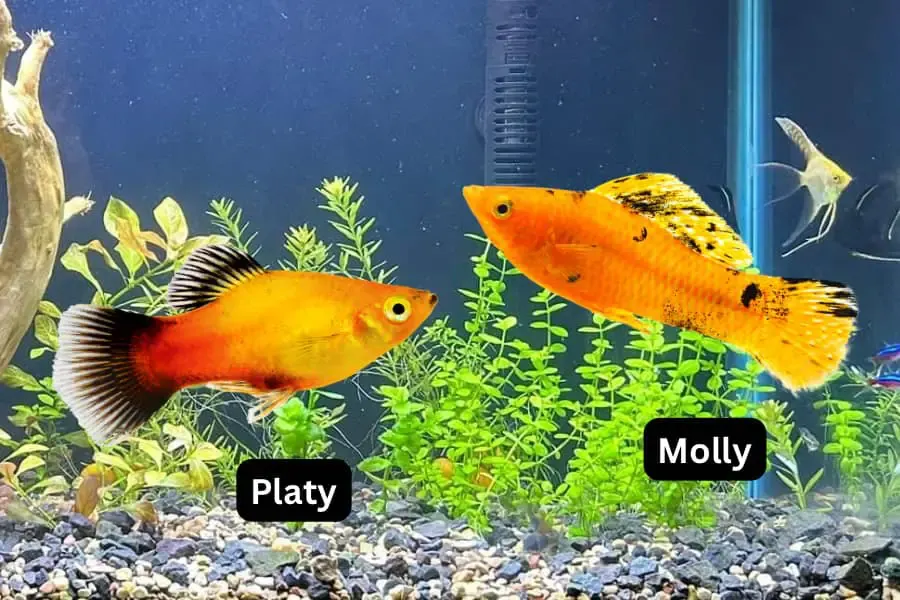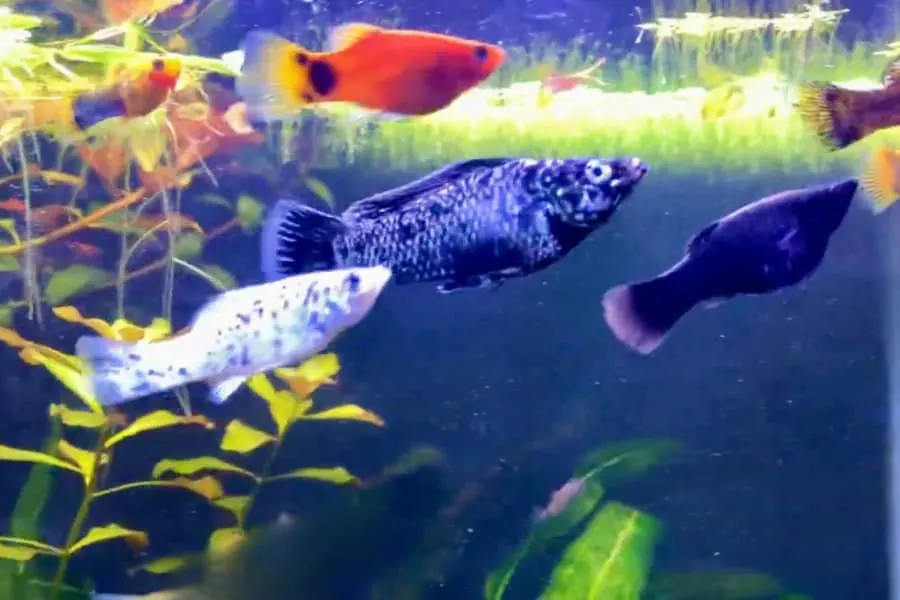This post may contain affiliate links.
Given the similarities in appearance, new hobbyists often find it challenging to distinguish between Platies and Mollies. Although both are livebearers and look identical, they are two different species of fish and can be told apart by looking at the size, shape, and mouth structure. Besides that, these popular livebearers are different in personality, temperament, and even habitat preference.
If you are in a dilemma as to which one to pick for your tank, read the following comparison to know which fish suits you the best.
How Is Molly Fish Different From Platy?

To simplify the key differences between Platys and Mollies, we have categorized them into these considerable factors:
Size, Shape & Mouth Structure
Growing up to an adult size of 3-4 inches, Mollies are larger than Platys, which tend to average at 2-3 inches.
A Molly has an elongated body shape, while a Platy appears slightly shorter and rounded.
The biggest distinguishing factor that tells apart these two seemingly resembling species is their mouth’s structural differences – Mollies have a more upturned mouth, whereas Platys have a front-facing mouth.
Typically, Mollies have longer fins than Platys. But, it varies based on the individual’s fish depending on its genetics.
NOTE: Mollies are of different types. Some varieties can be as large as 5-6 inches in size, such as Giant sailfin & Yucatan Mollies.
Water Preference & Ideal Habitat
Originally, Mollies are brackish-water fish, but many have been adapted to freshwater in the trade. In fact, most LFS you can spot nearby are probably dealing in freshwater-acclimatized or bred Mollies.
On the other hand, Platies are true freshwater fish that thrive in hard, alkaline water like most livebearers including Mollies. They can even handle soft water which Mollies can’t.
While both species are hardy, Platies are much hardier and tolerant of different extremes.
Mollies aren’t as forgiving of mistakes in tank management and are quite demanding in terms of water quality and diet.
For example, Mollies need enough vegetable matter in their diet. If not given, they may eat your plants.
Personality & Temperament
Personality-wise Mollies are the winner. They are more interactive and personable compared to the “somewhat dull” Platies.
However, Mollies prefer more cover and hiding spaces. Platies are more of an outgoing and social fish that love to swim in the open and toward the top of the tank.
For the most part, Mollies aren’t considered an aggressive species. But it really depends on the situation – such as, in overcrowded conditions, it’s not uncommon for Mollies to cause aggression. Usually, it’s the males trying to assert dominance and establish a pecking order.
When it comes to Platies, the livebearer has a reputation for being a peaceful fish. But again, in certain conditions, you may find them exhibiting aggressive behavior – such as, during mating season or when there are multiple males and not enough females to give company.
Species-wise, neither Mollies nor Platies are typically aggressive. However, depending on the circumstance and the individual personality of the fish, it can turn out to be a bully regardless of the species.
Molly Vs Platy – Which One Is Best For You?
Both fish are prolific livebearers with many similarities and a few differences. If you are considering either of these fish, ultimately the choice will depend on personal preference.
- Both are active fish – always swimming all over the tank.
- Both are colorful and come in a variety of colors to choose from. Mollies come in several types, such as lyretail, sailfin, and short fin, to name a few.
- Both are easy to breed.
- Out of the two, Mollies has the most personality.
- Both are considered big poopers, but Platies are even more messier given their tiny size.
- Platies are comparatively peaceful than Mollies.
- Platies are much hardier and more tolerant of water chemistry, unlike Mollies which are sensitive to even slight changes in the water chemistry.
- Given the size of Mollies, they need a bigger tank – 29 gallons is the bare minimum, whereas 40 gallons is a decent size. For Platies, you need at least a 10-gallon tank or preferably 20 gallons.
If you are an absolute beginner, we suggest you go with Platies. They are quite hardy, so even if you miss a water change now and then, they are going to be fine. And the best part? These are tiny, little fish that can easily be stocked in a smaller tank.
Are Platys and Mollies Compatible Tank Mates?

Platys and Mollies are of similar temperaments and make excellent tankmates. If you want to keep Mollies and Platys together and/or with other peaceful, community fish, consider the following factors:
Don’t Overstock
Mollies don’t like overcrowded conditions. If not given enough room, they tend to get aggressive towards others and even their kind. To ensure there remains a peaceful tank environment, avoid overstocking.
Platys are known for their mellow and gentle behavior. Although they don’t mind overcrowded conditions that much, if getting pushed by other fish, the tiny livebearers know how to protect themselves.
Male-to-Female Ratio
If you want to breed your fish, keep one male per 2-3 females. This is a healthy ratio to maintain; it ensures that the females don’t get stressed out or harassed by the male fish. Be it any species, males are always relentless – chasing and mating.
Can Mollies and Platies Crossbreed?
The general consensus is that Molly and Platy can’t crossbreed with each other. The reason being two different genus – Platies are in the genus Xiphophorus and mollies are in the genus Poecilia.
Genetically these two species are so quite apart that even if they try to mate, the eggs of the female will automatically reject the sperm of the male, not allowing itself to be fertilized.
Although there is no scientific study on this matter, Mollies and Platies haven’t produced any viable offspring so far in recorded history.
If you dig a little deeper and Google “Platy Molly Breeding,” and lurk around community forums, you will find there have been cases, reportedly – where hobbyists have one male Molly and a few female Platy, and one female got pregnant and gives birth to fry.
The most probable cause for such an instance could be that the Platy had been pregnant before it came into your tank. A female Platy only needs to be impregnated by a compatible male once to store sperm and give multiple births, 3-4 times on average.
Some Related Questions
Platy vs Molly – Which one is best?
There is no “one best” fish. Whether you choose Platy or Molly (or both), ultimately it depends on personal preferences and your willingness to do what it takes to maintain a healthy aquarium environment.
Do mollies need salt in their water?
Some Molly species (such as black molly) require salt in their water, while some are fine without it. Most mollies in the trade are acclimated to freshwater and don’t need salt.
How to tell the difference between Mollies and Platies?
The best way is to focus on the fish’s mouth or lip structure – Mollies have an unturned mouth and Platies have a front-facing mouth.
Can Platy Breed With Mollies?
No! Platys and Mollies are of different genus, and therefore can’t crossbreed.
Conclusion
So this is pretty much it for this article. We hope now you feel confident in your ability to tell Molly apart from Platy, and are well-versed with the similarities and differences between the two popular livebearers in the hobby.
